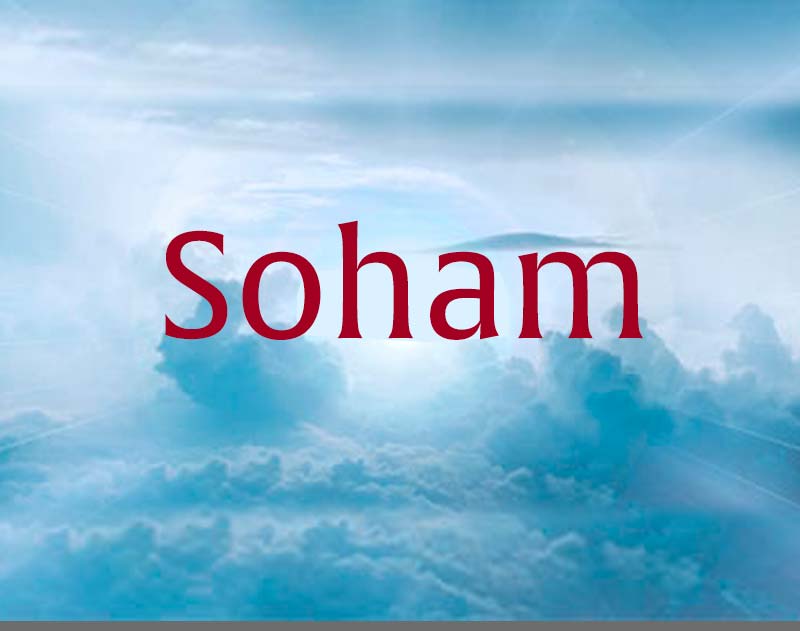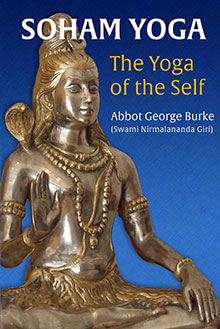
Q: Can we consider Soham as a Name of God?
Most certainly. In fact it is the ultimate Name of God according to the Brihadaranyaka Upanishad, which says: “In the beginning this (world) was only the Supreme Self [Paramatman], in the shape of a person. Looking around he saw nothing else than the Self. He first said, ‘I am Soham’ [Soham asmi]” (1:4:1).
And Soham is also our name, as well. At the end of the Isha Upanishad in the sixteenth verse the individual spirit (jiva) is declared to say in its ascent to the Absolute: “I am that Purusha [Spirit-Self]: I am Soham.”
So both Brahman and our Atman (spirit-self) ARE Soham.
Soham is itself the Soham Bhava that is the essential Consciousness of the Paramatman and the jivatman. Here is a section from Chapter One of Soham Yoga: The Yoga of the Self, about Soham Bhava.
Soham: both a Mantra and the Eternal Name of God and Man
A mantra is any sound formula that by its own inherent vibration creates a change, either inner or outer. Soham is therefore a mantra–the supreme mantra. But the secret of its supremacy is the fact that it is also the Divine Name of both God, the Paramatman, and the individual Self, the Jivataman. This is indicated by the two oldest Upanishads–the Brihadaranyaka Upanishad the the Isha Upanishad.
The Brihadaranyaka Upanishad says: “In the beginning this [cosmos] was only the Supreme Self [Paramatman], in the shape of the Purusha. Looking around he saw nothing else than the Self. He first said, ‘I am Soham’ [Soham asmi]” (1:4:1). Thus we see that Soham is the original, primal Name of Brahman the Absolute, the Supreme Self.
And since the Self (Atman) of each sentient being is one with the Absolute, it is also the Name of each one of us: we, too, are Soham. In the sixteenth verse of the Isha Upanishad at the time of death the departing Self of each human being says: “I am that Purusha [Spirit-Self]: I am Soham” [Soham asmi].
The great yoga master, Sri Gajanana Maharaj of Nashik, said: “[Aspirants] should try to obtain ever-lasting peace by the mantra of Soham.… This simple method of Nama Smarana [Remembrance of the Divine Name] surely and certainly leads to the same goal.”
Soham Bhava: the beginning and the end
A Brief Sanskrit Glossary defines bhava: “Subjective state of being (existence); attitude of mind; mental attitude or feeling; state of realization in the heart or mind.” Soham Bhava is an eternal element in the essential being of both God and each one of us. Though essentially consciousness, it is also the original (and originating) potential of both the cosmos and each individual sentient being. At the beginning of creation, it becomes an internal movement within Brahman, a stirring, a fecundity, the seed of relative existence, though itself beyond relativity. Soham Bhava is the Original Face which is reflected in each individual spirit. The Soham Bhava is itself Self-knowledge, the Atmajnana. This is because Soham Bhava is the pure consciousness of the Self: Atma Chaitanya. It is the Self whose essential nature is Consciousness. Therefore Soham Yoga is the direct means to Self-realization.
The Soham Breath
To realize its own potential the Soham Bhava becomes the Soham Breath within all. The Rig Veda says that in the beginning the One “breathed breathlessly.” The Soham Breath is the archetypal breath within God and within all beings and is the uniting principle of the Supreme Being and individual beings.
The Soham Breath is itself Yoga and Yogi. On the cosmic level it is the root or seed that is the beginning of all things, the Holy Breath, the Agia Pneuma, the Holy Spirit, the Holy Light, from which all things proceed and into which all things are ultimately resolved. It is the Primal Breath within all beings that enables them to manifest, evolve and return to their Origin. Throughout eternity Soham is the unfolding story of every one of us, including God. Soham is the root of the breath, the life within each sentient being, ripened and changed from potential to actual, the impulse that is both creation and entry into creation, that which expands and evolves until it manifests in many stages from most subtle to most objective as the physical breath.
First it is the force that impels the individual onto the path that leads into involution (relativity), into experience and identity with increasingly complex forms of manifestation; and it is also the impulse that moves the spirit onto the path of evolution–of growth out of relativity. Second, it is the beginning of duality: a vast chain of constant cycling between two poles–negative and positive–that makes relative existence possible, both as evolving consciousness and evolving organism.
The spirit travels along the path of involution until it reaches the experience of self-awareness and self-reflection (self-analysis) within a human body sufficiently developed to permit and produce that awareness. Then it begins the path of evolution back to infinity. Of course, the two paths are really one; it is only a matter of the direction being taken. The point where involution becomes evolution is a kind of watershed or continental divide. All this is a direct production of the original breath, the Soham Breath which takes place both macrocosmically and microcosmically. This has a profound yogic significance, as the dedicated Soham yogi will perceive.
In yogic treatises we find it stated over and over that the breath is the essence of our existence. Prana means both life and breath in Hinduism and Buddhism. In fact, the word Atman (Self) comes from the root-word at, which means “to breathe.” Other religions also use the same word for both spirit and breath: in Judaism, ruach; in ancient Greek religion and Eastern Christianity, pneuma; in ancient Roman religion and Western Christianity, spiritus which comes from spiro, “I breathe.”
Soham Bhava is the root and Soham Breath is the flower. “So” is the inhalation and “Ham” is the exhalation. In the original stage, “So” produces the inhalation and “Ham” produces the exhalation. But after a few stages along the path to relativity, inhalation produces “So” and exhalation produces “Ham.” Then in the heights of evolution things go back to the original mode. For the breath itself is an extension-manifestation of Soham.
 3 Ways to Discover More:
3 Ways to Discover More:
Read Soham Yoga: the Yoga on the Self for free on our website.
Download Soham Yoga: the Yoga on the Self as a PDF from our E-Library.
Buy Soham Yoga: the Yoga on the Self from Amazon in paperback or ebook.







